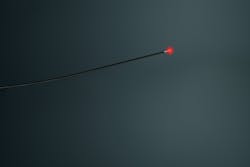Shaped glass diffusers for medical use handle high laser powers
Phototherapy has come into its own as a tool for treating medical conditions, including treating cancers, psoriasis, enlarged leg veins, and so on. Localized light-based treatments that require high intensities benefit from laser light delivered through optical fiber. The remaining problem is how to deliver the light to the area being treated in a precise distributed manner while maintaining high efficiency and durability for clinical use. For this purpose, engineers at Schott (Mainz, Germany) have developed diffusers made of what Schott calls “glasslike materials” that produce a homogenous light output at high laser powers and can transmit visible, infrared, and ultraviolet wavelengths with high efficiency; the materials incorporate scattering elements to deliver up to 20 W of laser light with high efficiency (low absorption). The ability to handle high powers is critical because plastic components melt or could cause tissue burns if they overheat.
Mounted on optical-fiber ends, the diffusers are biocompatible and physically durable, although they are designed for single-use instruments that are discarded after use (as opposed to repeated-use instruments that are sterilized for reuse). Diffuser geometries include flat, cylindrical, and spherical, as well as custom; the cylindrical diffusers are typically 5 to 50 mm in length, diameters down to 100 μm, and an optical output of up to 500 mW/cm2, while the spherical diffusers typically range from 0.3 to 1 mm in diameter and support optical powers of up to 20 W. The diffusers work at wavelengths ranging from the near-UV into the near-IR (NIR) at up to wavelengths of 2 μm. “Our next anticipated R&D steps are further improving transmission in the NIR/IR spectrum, as well as realizing challenging emission patterns,” says Juergen Hammerschmidt, head of new business development at Schott Lighting and Imaging. Contact Haike Frank at [email protected].
About the Author
John Wallace
Senior Technical Editor (1998-2022)
John Wallace was with Laser Focus World for nearly 25 years, retiring in late June 2022. He obtained a bachelor's degree in mechanical engineering and physics at Rutgers University and a master's in optical engineering at the University of Rochester. Before becoming an editor, John worked as an engineer at RCA, Exxon, Eastman Kodak, and GCA Corporation.

